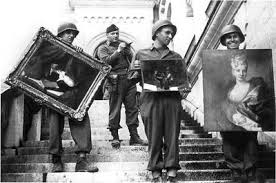
The “Monuments Men” produced and directed by George Clooney did not really receive the warm welcome expected especially with its all-star cast. The critics were not really impressed and they are certainly vocal about their disappointment.
However, the story of the men who inspired the movie who were sent on a dangerous and daunting mission to rescue the great art works and cultural collections of Europe during the World War II is really worth immortalizing. And of course, because of the movie, the generation of today get to see the contributions, sacrifices and the work of the Monuments Men and Women during one of the most critical period in history.
The Monuments Men salvaged what they could from the looted art works hidden by the Nazis. Many of these pieces were successfully traced and returned to their rightful owners. After the war, the legacy of the Monuments Men continues as the mission of identification and restitution of art go on.
The Monuments Men, especially the American membership, went on to become curators and directors of museums in the United States. They contributed to the enrichment of art in these museums and at the same time preserve these art for the future generations to see and experience.
One of the collections that the Monuments Men saved is “The Mystic Marriage of St. Catherine” by Peter Paul Ruben. The life-size collection, which dates back to 1633, shows the Virgin Mary carrying in her lap the Child Jesus. The art work is attributed to the sainthood of Catherine of Alexandria. The eccentric choice of palette and brushwork produced a truly magnificent and mystic air that only a genius of an artist can produce.
Hermann Goering, who was tasked to head the Nazi plunder of art, was reportedly responsible for the looting of the masterpiece. He “collected” the painting from a Jewish banker and industrialist Leopold Koppel who had one of the greatest art collection in Berlin. The art piece eventually ended up in collection point in Munich as confiscated art.
Art historian Otto Wittmann Jr. became in charge of the Office of Strategic Services in Washington and became involved in the investigation of Nazi-plundered art during the war. He then frequented the collection point in Munich.
After the war, Wittmann became the associate director of the Toledo museum. He was then informed of a former colleague of the OSS and also art curator of the Metropolitan Museum of Art that the painting of Ruben was available. The painting was returned to Koppel’s son, Albert, who then wished to sell the stolen masterpiece. The Metropolitan, however, was not confident of the authenticity of the painting so they had reservations in buying the art work.
Wittman, however, was convinced that the painting was the original painting and proceeded to buy the masterpiece for the museum in Toledo in 1950.
Wittman’s expertise in art and his gathered experience over the years led him to conclude of the authenticity of the painting and after several tests, he was proven right. The painting is one of the exemplary pieces in the impressive collection of the museum. The painting is highly influential and historical in 17th century European painting and 19th century American painting.
The famous painting of Ruben, “The Mystic Marriage of St. Catherine”, is one of the many rescued art pieces that the Monuments Men contributed to enriching the American museums. And rescuing the art did not simply entail getting the Nazis to admit where the stolen art were and salvaging the art. It took years to trace and find the Nazi’s most kept secret.
